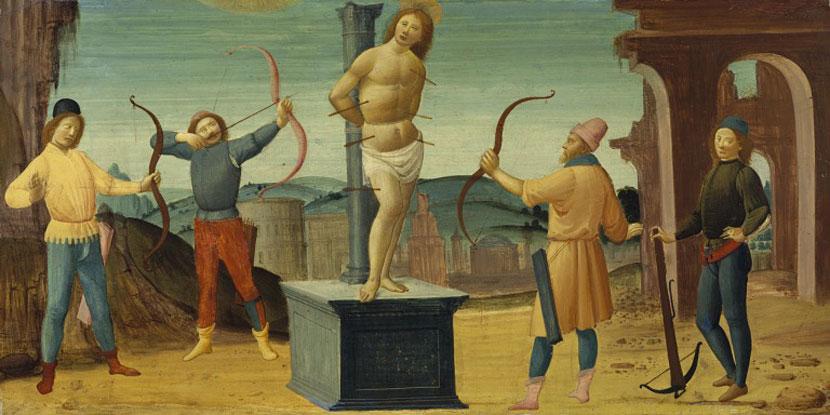
How did St Sebastian become a Gay Icon?
We look at how St Sebastian came to be known as a Gay icon from as far back as the late 19th century.

Martyrdom of St. Sebastian, Bartolomeo di Giovanni, 1496 - 1500 about
On the 20th January 287 AD, Saint Sebastian was killed by the Roman emperor Diocletian for his Christian beliefs. On that day, every year, people come together to celebrate the feast day of the Christian martyr. San Sebastian in Spain, is transformed with the sound of drums and barrels, as parades march through the city and flags are hoisted. However, since then Sebastian has also been named a Gay icon, as part of our pride and prejudice project we looked into how he came to be a figure in the LGBTQ+ community.

The Martyrdom of St. Sebastian (Album II), Gasparo Diziani, 18th Century
We have re-examed the art within our collections that depicts Saint Sebastian, in relation to his contemporary status as a ‘gay icon’. Sebastian was a favourite subject of medieval and Renaissance artists, who welcomed the challenge to paint the Saint’s contorted body. We have seven paintings and drawings of him from the 15th,16th and 17th centuries. Works in our collection by Bartolomeo di Giovanni, Gaspare Diziani and Maerten De Vos, like most images from this period, show the Saint as a handsome, semi-naked, youth and focus on the moment of his execution. They depict him tied to a tree or post, his bare torso pierced with arrows, often seemingly deriving a spiritual pleasure from his pain. It is thought that the abundance of such eroticised portrayals of the martyr’s naked, muscular, arrow-pierced flesh, inspired the cult following Saint Sebastian attracted within late nineteenth-century gay communities. The saint’s youthful good looks made him a symbol of homoerotic desire and male beauty. Others were drawn to the way depictions of the saint’s portrayed him as a ‘tortured soul’. They connected the shame, rejection and loneliness they experienced within society to the martyr’s experiences of persecution. Oscar Wilde even took on Sebastian’s name for a time after his release from prison.

An Angel sheathing a sword with St Roch and St Sebastian, Domenichino Attributed to; Joshua Reynolds Attributed to; Guercino Copied after, 1742 - 1743 possibly
It is these visions of Saint Sebastian, which have endured throughout the 20th and 21st Century. The artist and filmmaker Derek Jarman’s 1976 film of the Saint’s life, ‘Sebastiane’, for example, explicitly treated the martyr as a gay icon. Sebastian even featured on the front cover of gay magazine ‘reFRESH’. Other works in our collection, such as the drawing by Sir Joshua Reynolds (copied from one by Guercino produced in 1632-34) focus instead on Saint Sebastian as a protector against the plague and disease. The original drawing is believed to have been a preparatory sketch for an altarpiece for the church at Nonantola, near Cento. It was probably commissioned in thanks for the town’s reprieve from the plague in 1630. Since the onset of the AIDS epidemic, some LGBTQ+ people have also found solace or relevance in this image of Saint Sebastian as a protector against disease. Contemporary artists, such as David Wojnarowicz and Keith Haring, for example, who both eventually died of the disease, drew on Sebastian’s image in their later work.

reFRESH Magazine cover 2007 showing Sebastien Moura as St Sebastian
The version of Saint Sebastian by Bartolomeo di Giovanni in the Walker Art Gallery's collection has particular significance to LGBTQ+ histories as the artist himself was accused of same-sex activity in 1492 in Florence, Italy. Florence had been a relatively liberal place for its time under the rule of the Medici family, where homosexuality was tolerated and even accepted within artists’ circles. However, in 1492, the ruler of the Florentine region, Lorenzo de' Medici (1449-14492), died. Girolamo Savonarola (1452-1498) seized control of the city, outlawed homosexuality, and began burning any objects that might ‘lead citizens into sin’. Bartolomeo di Giovanni later died in poverty and his widow was forced to beg for money from the local church.
Ultimately we can not say definitively that St Sebastian was a gay man but does that really matter? Queer people have been denied visibility in history for centuries and finding relatability in a religious figure's story is a harmless way for queer people to feel connected to a part of history.
